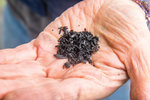

Francesco Tortorici’s first job out of college was designing rocket engines. Since then, he has lived around the country and around the world, in places like Norway, working as an engineer and a construction project management consultant for 30 years.
But after all that work over all those years, he realized he wanted to shift his focus onto something new—and something renewable.
That’s when Tortorici went down the “biochar wormhole.”
“It’s almost like everything I’ve done up to now has led me here,” he said, one gray February afternoon, standing over a small stove where a pile of wood scraps he had collected earlier were now in the midst of a process known as pyrolysis—where organic materials are burned at high temperatures in an oxygen-free environment.
Tortorici, who moved to Port Townsend in 2001, first learned about this process nine years ago when he attended an ETHOS Conference, which stands for Engineers in Technical and Humanitarian Opportunities of Service.
His passion for renewable resources and regenerative agriculture drove Tortorici’s interest in biochar. Since then, he has started his own biochar company, called Olympic Biochar, and began teaching classes on designing stoves that produce biochar.
He says he hopes to share his knowledge with students in Jefferson County, as well as gardeners, farmers and entrepreneurs because it’s good for the health of the planet.
So what is biochar?
“Terra preta,” or “black soil,” is a product of indigenous soil management, in which a mixture of burned organic material- charcoal, bone, broken pottery, compost and manure-were added to the soil. The charcoal content makes the soil look black—hence the name—and remains in the soil for thousands of years, binding and retaining minerals and nutrients.
Archaeologists have found biochar in the Amazon basin that’s been there for thousands of years, Tortorici said.
Biochar is essentially charcoal. But it isn’t just made from wood—it can be made from any organic, leftover waste, such as leaves, garden clippings, wood chips and even bones. (It is a good way to turn invasive weeds, like Scotch broom, into something helpful for the garden, Tortorici noted.)
Once biochar has been produced, it can be used as a soil amendment to add to farm fields, flower beds or veggie gardens.
There, it absorbs and retains moisture and nutrients. It also becomes a home for microbes, bacteria and mycelium.
“It enhances a healthy soil biome,” Tortorici said, “so that it becomes teeming with life.”
Delving deeper into the biochar wormhole, Tortorici learned that SeaChar, a Seattle-based non-profit, had been developing clean-burning stoves for coffee producers in Costa Rica. The stoves can burn any organic material (such as coffee plant leaves) to cook on, while also producing biochar. Because these stoves use the pyrolysis process—burning material in a no-oxygen environment, they produce little to no smoke.
The stoves can be made out of any found object, such as discarded paint cans, pieces of corrugated tin roof or even an Altoids tin. And anyone can make one, as Tortorici has learned, after leading classes at Blue Heron Middle School on making biochar stoves out of empty tomato cans.
Biochar in regenerative farming
But using a clean-burning stove isn’t the only way to produce biochar.
Brendon Hohmann, a farmhand, carpenter and maintenance manager at Natembea, a cooperative farm in Port Townsend, has found creating biochar can serve a multitude of purposes.
“We’ve had a lot of material from old infrastructure like fence posts, that has been dismantled,” he said. “This is a way for us to process that material and have a useful byproduct.”
Hohmann creates a giant pile of material and begins a process known as a “conservation burn,” where the pile is burned from the top down (with a burn permit from the county, of course). As the material burns, it transforms into piles of charcoal, which Hohmann rakes out and quenches with water.
“I see the main benefit of this method as being able to quickly process a lot of material while reducing the impacts of air pollution,” he said. “Burning in this way produces almost no smoke and the burn is complete within a few hours, as opposed to burning and smoldering for days or weeks, creating lots of smoke.”
The charcoal is a byproduct of the burn, but one that brings value to the farm, he said.
He lays the charcoal in animal bedding at the farm where they are raising herds of goats and it absorbs nutrients.
“By absorbing nutrients, primarily from animal bedding, and incorporating into compost, we are able to use the resulting biochar as a soil amendment,” Hohmann said. “This also significantly reduces odors around the animal pens.”
Charcoal is valuable as a fuel for cooking, black-smithing and other traditional crafts, Hohmann added.
“It’s a valuable tool that has been around for thousands of years,” he said. “I’m not even sure if people know how long people have been using it.”
Anyone can make biochar
Tortorici is supplied with biochar from the Port Townsend Paper Mill.
But what he loves about the charcoal is that anyone can make it. He’s worked with students at Blue Heron Middle School, showing them how to poke holes in empty tomato cans to create miniature clean-burning stoves that can then produce small amounts of biochar.
He has worked with the Port of Port Townsend, implementing a pilot project to use biochar to help clean stormwater runoff, since it can absorb positively charged ions like zinc and copper.
He donates biochar to school and community gardens, most recently spreading biochar along with mulch in the orchards at Blue Heron Middle School.
He encourages gardeners to learn about using biochar with their planting: just a small amount sprinkled in a plant’s root spread when planting can go a long way in helping it use the nutrients biochar stores.
For him, the best part about falling down the biochar wormhole is teaching others about its uses.
On March 7, he will give a workshop and biochar demonstration at the Global Earth Repair Foundation classroom at Ness’s Corner in Port Hadlock from 1 to 4 p.m.